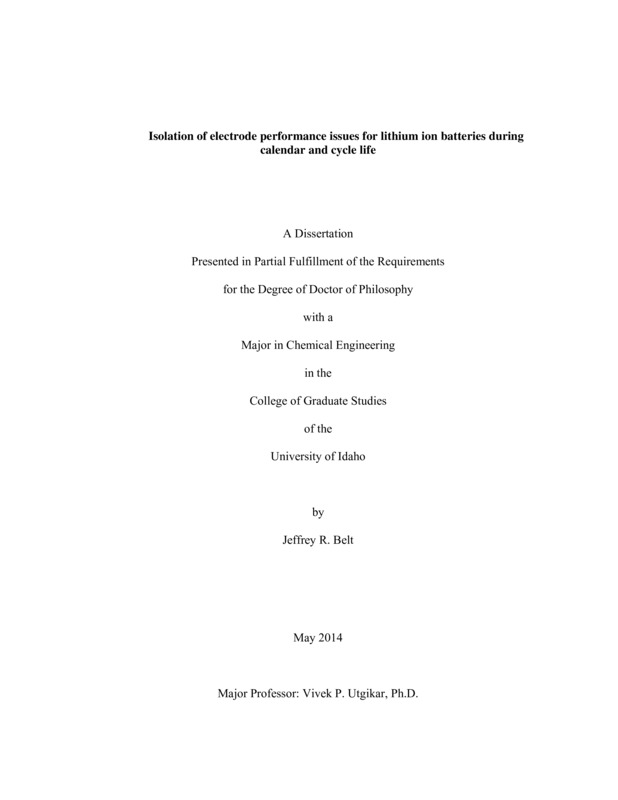Isolation of electrode performance issues for lithium ion batteries during calendar and cycle life
Belt, Jeffrey. (2014). Isolation of electrode performance issues for lithium ion batteries during calendar and cycle life. Theses and Dissertations Collection, University of Idaho Library Digital Collections. https://www.lib.uidaho.edu/digital/etd/items/belt_idaho_0089e_10322.html
- Title:
- Isolation of electrode performance issues for lithium ion batteries during calendar and cycle life
- Author:
- Belt, Jeffrey
- Date:
- 2014
- Keywords:
- Calendar life aging Cycle life aging Lithium Ion Battery Reference electrode
- Program:
- Chemical Engineering and Materials Engineering
- Subject Category:
- Chemical engineering; Energy
- Abstract:
-
In an effort to reduce fuel consumption by improving vehicle efficiency, several automakers have offered electrified vehicles options to consumers. Development, testing, in-depth failure analysis and modeling of lithium ion battery technology are critical for the continued development and growth of the electrified vehicle market. In this work, lithium ion cells were cycle and calendar aged under various conditions, such as temperature and state of charge, to identify capacity fade, resistance rise and power fade associated with the Plug-In Hybrid Vehicle (PHEV) usage scenarios. A reference electrode was inserted to several cells to separate the electrode performance from the cell performance. The testing results were modeled to estimate life for the cells at common operating temperatures.
Focused destructive analyses were performed with half-cell testing utilizing a lithium reference electrode to understand the mechanisms that affect power, energy, resistance and capacity fade in the path dependence studies of commercial Lithium Ion cell testing. The reference electrode is used to investigate voltage characteristics of the individual electrodes throughout calendar (i.e., zero current) and current cycle-ageing regimes. The response of the electrode voltages (vs. reference) to a given current pulse prior to and during interruptions of the aging regime indicates that the resistance of the positive-electrode is much larger than that of the negative electrode.
Modeling of the calendar and cycle life testing results using an Arrhenius based semi-empirical model was demonstrated for temperature and state of charge accelerated calendar and cycle life testing. Calendar life estimation has become critical for the continued development of electrified vehicles and the warranties associated with them. A methodology is presented that can be used to characterize the performance degradation of cells for use in automotive applications.
Battery manufacturers, by understanding the factors that limit life and which electrode limits cell performance over life can improve cell technology: life, performance, and cost. Battery advancements will be accompanied by reduced petroleum consumption, which will facilitate the acceptance of electrified vehicles that will be competitive at the same cost and performance level in a market dominated by gasoline engines.
- Description:
- doctoral, Ph.D., Chemical Engineering and Materials Engineering -- University of Idaho - College of Graduate Studies, 2014
- Major Professor:
- Utgikar, Vivek
- Committee:
- Cheng, I. Francis; Edwards, Dean; Phongikaroon, Supathorn
- Defense Date:
- 2014
- Identifier:
- Belt_idaho_0089E_10322
- Type:
- Text
- Format Original:
- Format:
- application/pdf
- Rights:
- In Copyright - Educational Use Permitted. For more information, please contact University of Idaho Library Special Collections and Archives Department at libspec@uidaho.edu.
- Standardized Rights:
- http://rightsstatements.org/vocab/InC-EDU/1.0/

